Awani Blog
Traditionalist or Adventurer? 10 Luxury Fruit Condiments for Asian Comfort Food
Diana Lai matchmakes Awani tropical flavours with Peranakan Heritage (and Other) Food
If you grew up in Singapore or Malaysia, luxury food condiments simply meant those with the best flavour that your family would always eat with favourite food or snacks. As such, any self respecting person would know exactly which condiment should traditionally accompany those foods.
For example, you would eat chicken rice with a heavenly amalgam of pounded ginger, chilli and garlic, dip your Nyonya soon kueh (steamed turnip dumplings) into a pungent well of chilli and sweet black sauce, your chunky roast duck would only be complete with a spoonful of honeyed hoisin or plum sauce, and you would dab colourful sweet rice cakes into a little bowl of orange sugar and freshly grated coconut for extra flavour.
To get a new take on the old, we turned to Singapore based Diana Lai who is a second generation Singapore born Nyonya and is passionate about Singaporean and Malaysian heritage food… er well actually all good food!
For those readers not familiar with the term Nyonya, they are females of the Peranakan or Straits Chinese culture that blend elements of Chinese and Malay aspects of life. Male Straits Chinese are called Babas. Peranakan food is celebrated in both Singapore and Malaysia for the complex and labour intensive preparation that results in highly flavoursome and mouth-watering dishes on the dinner table. In Diana’s family, as for many similar families, it was a job for mums, sisters, grandmas and aunties.
Modern life makes all hands on deck in a Peranakan kitchen a scene from the past. However, that’s not to say that interest in heritage food has waned. On the contrary. By day, Diana’s life is steeped in the demanding world of advertising and luxury goods retailing. But throughout her life, Diana has been passionate and curious about the food that she eats. Traditional flavours and condiments are part of her upbringing and evoke happy childhood days and family get togethers.
An accomplished cook, Diana is also keen to experiment. We were thrilled when she decided to try out some of our tropical fruit preserves to create a different perspective on food condiments that taste of little luxury and achieve best flavours for some of her favourite heritage (and contemporary) dishes.
Awani tropical fruit preserves were created as jams and marmalades for the breakfast tables of Bali’s top hotels. They are intensely fruity and fragrant, the flavours clean and pure on the palate. Over the years, delighted customers and foodies have used our jams to pair with cheese, make cocktails and create delicious and innovative pairings.
Here are Diana’s 10 pairings where she matches a food or snack that is traditionally eaten with a well-known dip or condiment, with one of our tropical fruit preserves.
So, the question we have for you is: are you are Traditionalist or an Adventurer?
Read on to find out more and we would love to hear your feedback or other thoughts. Please drop us a note or sign up to our newsletter.
Credits:

Diana Lai food pairing and styling
Connect with her on Instagram @dianalai_passionforfood
or by email: [email protected]
Photography by Pericles Lagonikos
1. Glutinous Rice Banana Leaf + Balinese Tangerine Marmalade
Glutinous rice dumplings have a place in most types of Chinese regional cuisine. They are the ultimate in comfort food! Piping hot from the steamer, it is a pleasure to peel away the fragrant banana or lotus leaf parcelling layer to reveal glistening grains of sticky glutinous rice and enjoy the tasty filling of pork, chicken or seafood.

The Nyonyas adapted the recipe and added their signature dried sambal prawns as a filling. This version of a rice dumpling is served cold, wrapped in banana leaf and popular as a snack at any time of day. The soft, chewy rice evens out the strong spicy sweet sambal flavours of the little rice roll.
Traditionalist: Kecap Manis
Traditionally, a Nyonya rice dumpling is dipped it into a heavy, sweet deep black sauce, known as kecap manis which is both deeply salty and sweet and eaten liberally in the countries of South East Asia.
Adventurer: Balinese Tangerine Marmalade
Our Balinese tangerine marmalade has been called a “lady” marmalade because of its gentle citrus fragrance and slight tropical citrus bitterness. However, gentle does not mean mild! From the Indonesian citrus fruit “sumaga”, the flavour of this green skinned orange are intense and long lasting. As a food condiment, it adds a bit of luxury, fragrant fruitiness to the spicy sambal that also complements the chunkiness of the glutinous rice.
2. Ngo Hiang Stuffed Beancurd Skin + Lime Marmalade
Beancurd or tofu is the most versatile of Asian foods and can take many forms. These crispy, savoury rolls are made with a casing of bean curd skin stuffed with pork and prawns. Actually, there is no end to what you can add into the filling.

This Straits Chinese version of tofu roll is called Ngo Hiang and is originally a Fuchou dish from South Eastern China. It made its way into Nyonya cuisine in Singapore and is a favourite during festivals including Chinese New Year. The name Ngo Hiang means Chinese five spice and is an essential seasoning in this dish. The tofu roll is stuffed with a filling of pork, water chestnuts and spring onions and then steamed before being deep fried.
Traditionalist: Fresh Lime Juice
A squeeze of fresh tropical lime is often added to the tofu roll so when you eat it, the acidity of the lime cuts through the oil of the deep fried bean curd skin.
Adventurer: Tropical Lime Marmalade
Awani’s lime marmalade is a delightful assault on the senses. Prickling with sharp tropical lime flavours, the sweet/sour/bitter character of this preserve complements the crispiness of the roll and its filling, adding a further layer to its flavours and textures.
3. Soon Kueh, Turnip Dumpling + Tamarillo Jam
A large number of Chinese migrants from Guangdong (Canton) province arrived in Singapore from an area called Teochew (in Cantonese “Chiu Chow”). Their cuisine joined the melting pot of delicacies from the south eastern regions of China. The beautiful snowy white steamed Soon Kueh is a traditional Teochew dumpling made from rice and tapioca flour and filled with cooked Chinese turnip (or Chinese radish) and chopped bamboo shoots from which the dumpling gets its name.
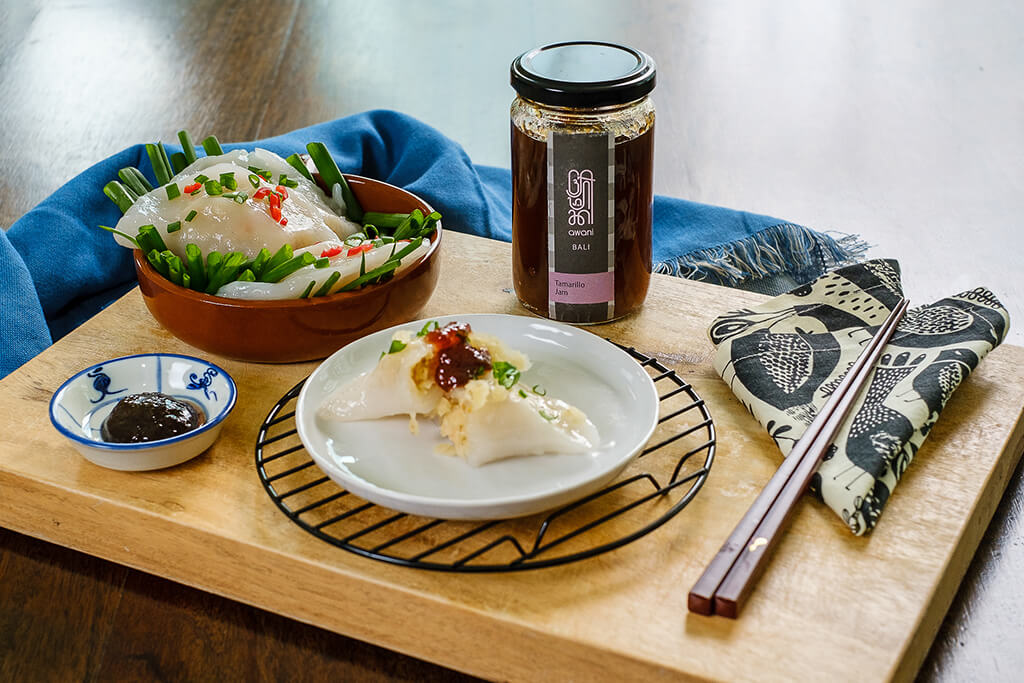
The innovative Nyonya aunties made the Teochew recipe their own by adding Chinese mushrooms, dried prawns and black fungus as a filling. The dough is soft and glutinous but should not be too heavy.
Traditionalist: Chilli and Kecap Manis
A snack for any time of day (or night!), the usual condiment is chopped red chilli and black, sweet sauce (kecap manis – described earlier).
Adventurer: Tamarillo Jam
We would describe our tamarillo jam as a complex and elegant entity. The fruit is known as a tree tomato and originates from South America. After cooking into a conserve, the fruit takes on delicious, fruity, berry, plum and passionfruit overtones that complement the salty dried prawns, and crunchy fungus and mushrooms in the soon kueh filling.
4. Roast Duck + Mango Jam
Cantonese roast duck is one of the best known and best loved international Chinese dishes. From Hong Kong, to Singapore, to London, to New York, wherever there are Cantonese or a Chinatown, for sure there will be roast duck! Now, as to which city can boast the best, that has to do with the provenance and rearing of the bird.
Its plump rich, gamey flavours are enhanced by an enticing marinade of five spice, rice wine, dark and light soya sauces and ginger. The skin is prepared separately so that it is wafer thin and crispy. The duck can be served whole on a banquet table, or it can be deconstructed and shredded to be assembled into a pancake with finely sliced strips of cucumber.
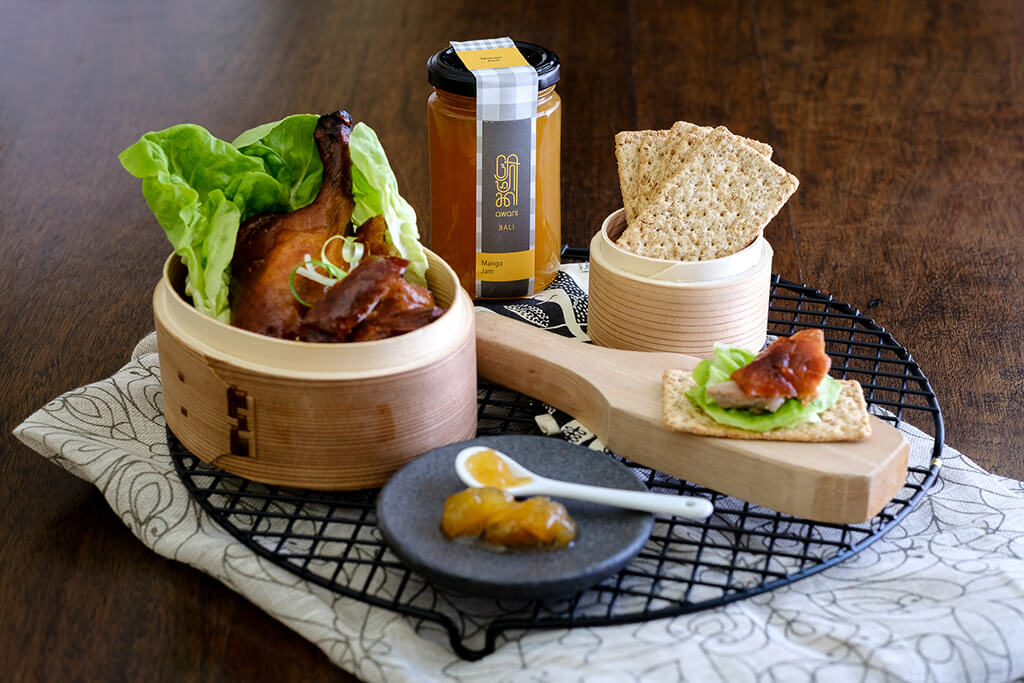
Traditionalist: Plum or Hoisin Sauce
A little dish of plum sauce usually accompanies a serving of Cantonese roast duck. The sweetness melds with the fat of the duck skin and complements the spiced, aromatic flavour of the meat.
Adventurer: Mango Jam
Our mango jam is made with the freshest, ripest harum manis mangoes, the king of Indonesian mangoes. They are sweet and fragrant, almost honeyed. The taste of our mango luxury food condiment gives a rich, fruity layering to the roast duck, lifting the flavour of the meat and taking this unusual delicious blend of flavour into fusion territory. It is Asian, but not quite Asian as mango jam is a bit oxymoronic, especially with Cantonese duck!
5. Nyonya Glutinous Rice Cakes + Tamarillo Jam
This is the snack to eat while watching a good movie – sticky, crunchy and moreish! There is something very comforting about sweetmeats made with rice flour. Maybe it’s the chewiness infused with an inherent savoury, salty taste.

These Nyonya rice cakes are just that! Glutinous and dumpling like, traditionally they are eaten on days of the full moon after Buddhist prayers. The filling is dried prawns and peanut, a potent savoury mix. Save some room for dinner though!
Traditionalist: Chilli and Kecap Manis
Like some of the snacks we have talked about so far, the conventional accompaniment to these glutinous rice cakes is the rich, sweet and salty dip of chilli and sweet black sauce.
Adventurer: Tamarillo Jam
Tamarillo jam will add an entirely different dimension to eating these peanut and dried shrimp infused rice cakes. It will add a lovely rich, sour fruitiness that will seem somewhat Asian but not quite. The sweet-sour flavours will complement the saltiness of the savoury rice cake and the chewy, crunchy textures.
6. Siew Yuk + Pineapple Jam
Siew Yuk is what overseas Chinese dream of when they live somewhere they can’t get it and the only way to eat it is to make it at home. It is Chinese roasted pork with a crispy skin and soft but firm layer of pork fat in between that gives way like butter when you bite into it.
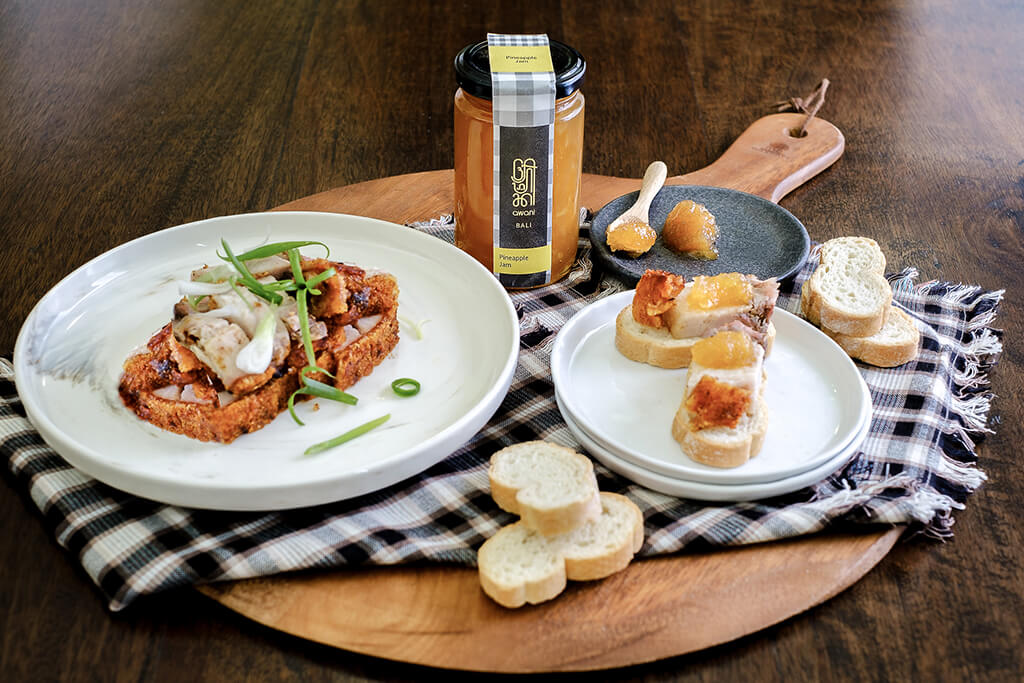
The crispy skin is a bit like pork crackling but more uniform in shape as an even, albeit pockmarked cover for the piece of meat beneath it. Before roasting, copious amounts of salt are rubbed into the skin, drawing out moisture and allowing for an easier crisping of the skin during the cooking process. There is a residue saltiness in the pork after cooking.
Traditionalist: Mustard and or Sugar
Interestingly mildly piquant English mustard has been the dip of choice for many siew yuk lovers. Otherwise, at the other end of taste preferences, is a bowl of dipping sugar.
Adventurer: Pineapple Jam
The pineapples that go into making our pineapple jam are grown on sun drenched volcanic slopes of Indonesia. They are crisp, dry and sweet. This tropical fruitiness sits brilliantly alongside the saltiness and texture of the pork meat and crispy skin. It has just the right balance and adds unexpected joy to this dish.
7. Huat Kueh Rice Flour Cup Cakes + Strawberry & Kaffir Lime Jam

Huat Kueh are beautiful little cupcakes made with rice flour and steamed in ceramic tea cups giving them their cutesy shape. The name “huat” refers to the rising process during steaming and also, as they accompany temple prayers, resembles the word “fatt” which means good fortune and prosperity. They are familiar as offerings, kept in boxes from the local bakery, to be devoured after prayers. They are fluffy and moist and, eaten without accompaniment, are not too sweet.
Traditionalist: Orange Sugar and Grated Fresh Coconut
A traditional pairing has the steamed rice cakes dipped into a little orange sugar and grated fresh coconut.
Adventurer: Strawberry Kaffir Lime Jam
A modern and delicious accompaniment to this humble cake is strawberry kaffir lime jam. The fruity and exotic lime flavours create a lovely, surprising lift for these homely cakes.
8. Panna Cotta + Pink Guava Jam
Panna cotta, like many international dishes, is a recent addition to best loved foods in Singapore! As a city that has constantly absorbed and adapted to external food influences, it is extremely well versed in the food culture of other countries.

A real panna cotta does not hold back on dairy content. So if you love cream, this one is for you! (If you don’t or you can’t, please move onto our next pairing suggestion!) We would be so bold as to suggest that Diana’s creamy panna cotta paired with our best selling pink guava jam is a match made in heaven, the very definition of a luxury food condiment that we can use creatively for best flavour in this beloved Italian classic!
There is nothing traditionalist about this combination, just pure ecstasy from bringing together the rich, smooth taste and texture of panna cotta, and a gorgeous fragrant pink guava preserve that has consistently been named by our fans as their favourite jam in the world. Try it!
9. Sugee Cake + Strawberry & Kaffir Lime Jam
For all Singaporeans and Malaysians, sugee cake will remind them of Eurasian home baking. A Eurasian culture was formed from the marriages of Asians and Europeans during the period of colonial rule.
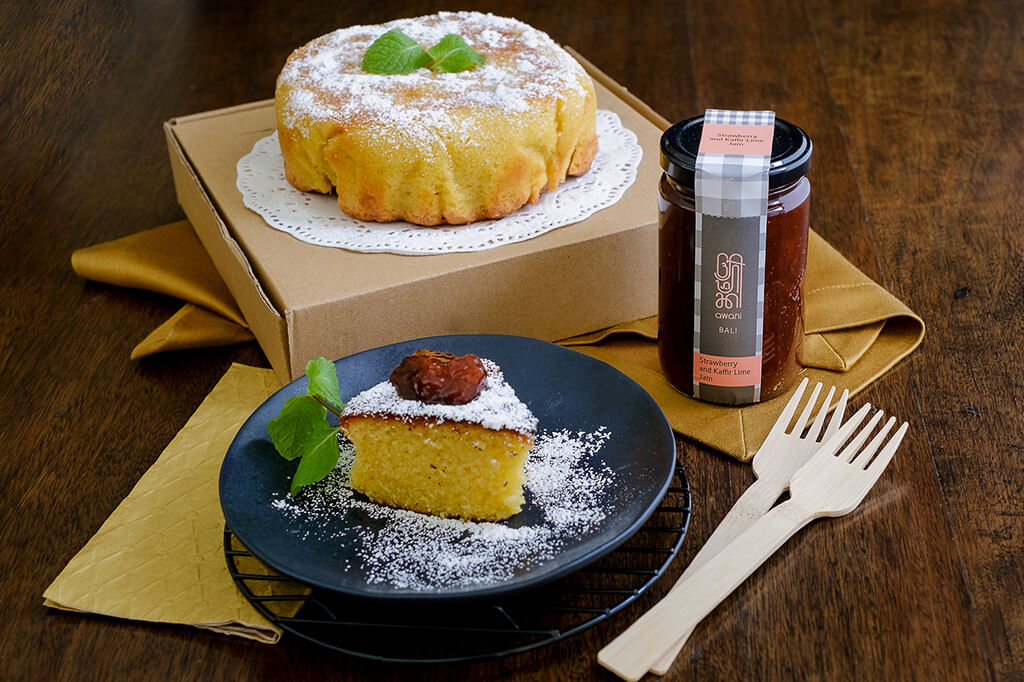
One facet of this was the introduction of cake making where none existed before. Sugee cake is a wonderful example of how influences from different cuisines can create something a little different from the traditional. Instead of using regular flour, sugee cake is made with semolina and almond flour that results in a pleasing, mildly crunchy texture.
Another ingredient that is used more commonly to make cakes in Singapore and Malaysia is buttermilk. To further extend the development of the sugee cake, Diana uses fruity, zingy, fragrant strawberry kaffir lime as jam filling for a truly exotic twist!
10. Roti Prata + Tropical Blossom Honey
Roti prata is the closest equivalent in Singapore/Malaysian cuisine to pancakes made with flour and milk in a western context. They are however flatbreads made with plain or wholemeal flour and ghee (clarified butter). Prata has rather a lot more fat content with the addition of ghee and this is what gives it an irresistible crispy, crunchy texture.
In the wonderful coffee shops or food courts of Malaysia and Singapore, they are eaten at all times of day, with curry sauce or dhal.
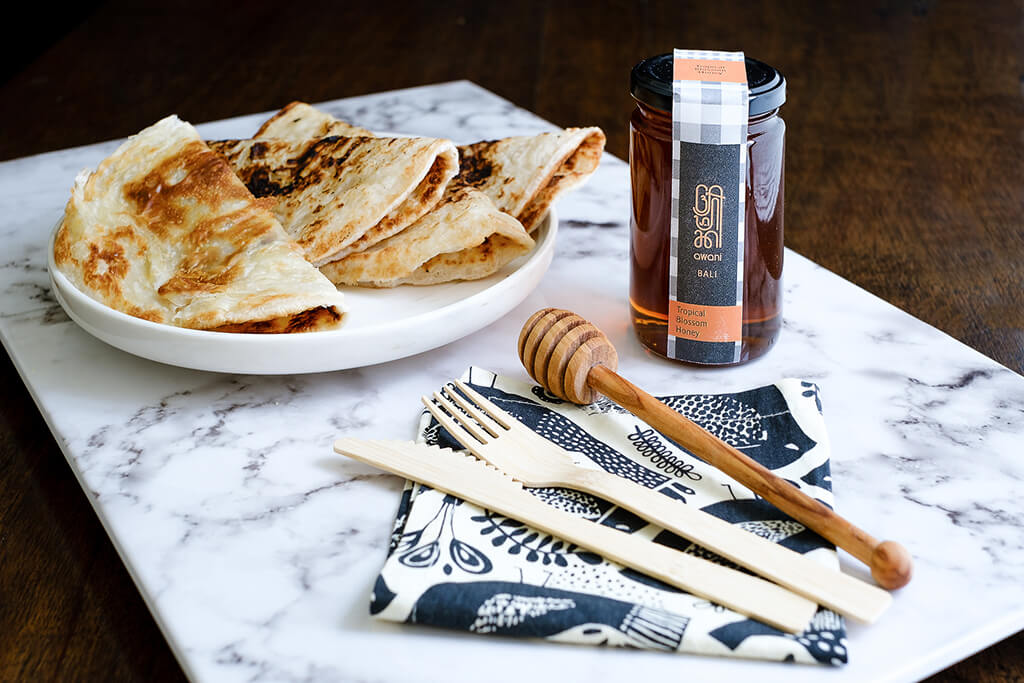
Here is Diana’s alternative way of serving prata, using our tropical blossom honey, a lustrous and fragrant pouring honey. Chop up some banana, add nuts and fresh toasted coconut.! It makes for a delicious tea-time (or breakfast!) alternative.
Further reading:
Want to get to know your Kueh better?
https://www.timeout.com/kuala-lumpur/restaurants/ultimate-guide-to-malaysian-kuih
Find out more about Ngo Hiang Bean Curd Rolls
On the Trail of the Phoenix – Grandma’s Ngoh Hiang
A Singapore Soon Kueh dumpling story
http://mysingaporefood.com/story/soon-kueh/
See the lovely ceramic Huat Kueh steaming cups
https://www.anncoojournal.com/huat-kueh-aka-fatt-koh/
The story of Eurasian Sugee cake
https://www.tastecooking.com/sugee-cake-traces-semolinas-path-malaysia/


